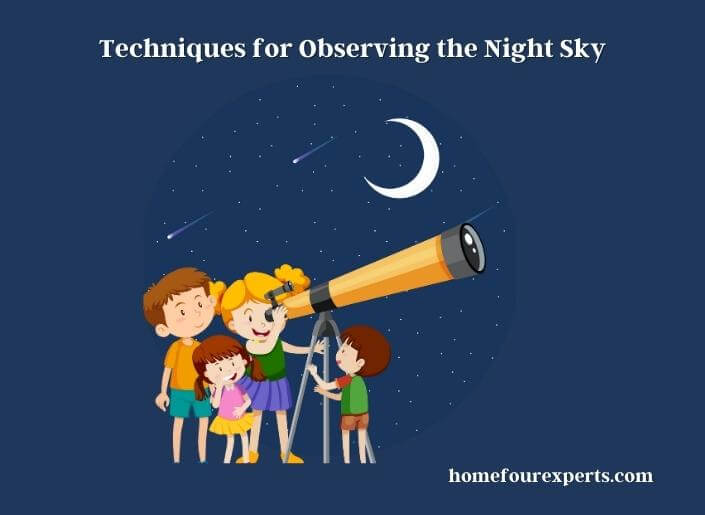Published on: March 19, 2023
Written by Camila Avery / Fact-checked by David Rowan
Stargazing is a captivating hobby that has been practiced for centuries. It allows us to connect with the universe and observe the stars, planets, and other celestial objects that surround us. Whether you’re a seasoned astronomer or a beginner, stargazing can be an enjoyable and rewarding experience.

Whether you’re looking to explore the night sky for the first time or enhance your stargazing skills, this article will provide you with the knowledge and tools you need to embark on your journey to the stars. So grab your telescope, put on your warmest clothes, and let’s get started!
Preparations for Stargazing
Before you head out to observe the night sky, there are a few things you need to consider to make your stargazing experience more enjoyable and successful.
Choosing the Right Location
The location you choose for stargazing is crucial. It should be away from light pollution, such as city lights or street lamps, to allow you to see more stars and other celestial objects. Look for a spot that is elevated, open, and free of trees and other obstructions that may obstruct your view.
Understanding the Night Sky
To fully appreciate stargazing, you need to have a basic understanding of the night sky. Learn about the constellations, their names, and their locations. Familiarize yourself with the phases of the moon and how they affect stargazing. Knowing what to expect will help you enjoy the experience more.
Weather Conditions
The weather plays a crucial role in stargazing. Choose a clear night with minimal cloud cover, and avoid nights with high humidity or excessive wind, which can affect your view and make the experience uncomfortable.
Equipment for Stargazing
While you can observe the night sky with your naked eye, investing in the right equipment can enhance your stargazing experience.
Telescope or Binoculars
A telescope or binoculars can help you see celestial objects more clearly and in greater detail. They come in a range of sizes and prices, so choose one that suits your budget and experience level.
Star Maps and Apps
Star maps and apps can help you navigate the night sky and locate specific celestial objects. They provide detailed information about the stars, planets, and other objects, making it easier to identify and observe them.
Red Flashlight
A red flashlight can help you see in the dark without affecting your night vision. Red light has a longer wavelength than other colors, making it less disruptive to your eyes.
Techniques for Observing the Night Sky
There are several techniques you can use to observe the night sky, depending on the celestial object you want to observe.

Naked Eye Observations
Naked eye observations are the simplest and most accessible way to stargaze. By just looking up at the night sky, you can observe the constellations, the moon, and other visible celestial objects. To enhance your experience, use a star map or app to identify and learn about the objects you are observing.
Telescope Observations
Telescopes can provide a more detailed view of celestial objects, making them ideal for observing planets, stars, and other deep-sky objects. To use a telescope, first, point it in the direction of the object you want to observe, then adjust the focus until the object appears clear and crisp. Remember to let your eyes adjust to the darkness before looking through the telescope, as it will help you see more details.
Planetary Observations
Planetary observations focus on observing planets in our solar system, including Venus, Mars, Jupiter, and Saturn. To observe planets, use a telescope with high magnification, and point it in the direction of the planet you want to observe. Planetary observations are best done on clear nights, as they require high magnification and clear viewing conditions to see the details of the planet’s surface.
Deep Sky Observations
Deep sky observations focus on observing celestial objects outside our solar system, including galaxies, nebulae, and star clusters. To observe these objects, use a telescope with a wide aperture and low magnification, and point it toward the object you want to observe. Deep sky observations are best done on moonless nights, as they require dark skies and minimal light pollution to see the objects clearly.
Tips for Successful Stargazing
Stargazing can be challenging at times, but with a few tips, you can make your experience more enjoyable and successful.
Patience and Persistence
Stargazing requires patience and persistence. Not all celestial objects are visible all the time, so it may take some time and effort to observe them. Be patient, and keep trying, and you will eventually see what you are looking for.
Dress for the Occasion
Stargazing is an outdoor activity, so make sure to dress appropriately for the weather. Wear warm clothes on cold nights, and light clothes on warm nights. Bring a blanket, hat, and gloves if necessary, to keep yourself warm and comfortable.
Keep a Record of Your Observations
Keeping a record of your observations can help you track your progress and learn from your experiences. Take notes on the objects you observe, including their location, appearance, and any other details that may be relevant. Use a notebook or a stargazing app to record your observations.
Pros & Cons of Stargazing
| Pros | Cons |
| Provides a sense of wonder and awe | Requires clear skies and good weather |
| Can be a relaxing and meditative experience | Can be time-consuming and require planning |
| Offers an opportunity to learn about astronomy and the universe | Requires equipment, which can be expensive |
| Can be enjoyed alone or with friends and family | Can be impacted by light pollution |
| Enhances appreciation for the natural world | May require travel to find a suitable observing location |
| Provides an opportunity for scientific observation and research | Requires patience and persistence |
| Can be a lifelong hobby with endless opportunities for learning and exploration | May be limited by physical and health restrictions |
As with any hobby or activity, there are both pros and cons to stargazing. For many people, the rewards of stargazing far outweigh the challenges. With a bit of preparation, patience, and dedication, stargazing can be an enriching and rewarding experience that deepens your understanding of the world around us.
Last Assumption
Stargazing can be a rewarding and fulfilling hobby for people of all ages and backgrounds. With the right equipment and a bit of knowledge, anyone can explore the wonders of the universe and gain a deeper appreciation for our place in it.
Remember, stargazing is not just about observing stars and planets, but also about taking the time to slow down and appreciate the beauty of the world around us. Whether you’re stargazing alone or with friends and family, take the opportunity to pause, reflect, and marvel at the vastness of the universe.
We hope this article has provided you with the information and inspiration you need to begin your stargazing journey. Remember to start with the basics, and don’t be afraid to experiment with different techniques and equipment to find what works best for you.
We would like to remind you to always respect the night sky and the environment in which you observe it. This means avoiding light pollution, taking care not to damage natural habitats, and being mindful of your impact on the environment.
Common Questions & Response
What’s the Best Time of Year for Stargazing?
The best time for stargazing depends on where you are in the world and what you want to see. Generally, the best time is during the winter months when the skies are clearer and darker. However, there are also plenty of celestial events that occur during other times of the year, so it’s worth researching what’s happening in the night sky throughout the year.
Do I Need a Telescope to Go Stargazing?
No, you don’t necessarily need a telescope to go stargazing. In fact, many celestial objects, such as the moon and planets, can be observed with the naked eye. However, a telescope can help you see more detail and enhance your stargazing experience.
How Do I Avoid Light Pollution When Stargazing?
To avoid light pollution, it’s best to choose a location away from cities and urban areas. Look for dark sky preserves or designated stargazing spots in your area. You can also use light pollution filters on your telescope or binoculars to reduce the impact of artificial light.
What Should I Wear for Stargazing?
It’s important to dress appropriately for stargazing, especially during colder months. Dress in warm layers and consider bringing a hat and gloves. It’s also important to wear dark clothing to avoid creating light pollution and disrupting your night vision.
Are There Any Apps or Websites That Can Help Me With Stargazing?
Yes, there are many apps and websites that can help you identify celestial objects and plan your stargazing sessions. Some popular options include SkyView, Star Walk 2, and Stellarium. You can also check online forums and social media groups for stargazing enthusiasts in your area.
About This Writer

Guys, I am Camila Avery and I love to help my mom to do indoor & outdoor activities. As a lady, I have passed my time on gardening, home improvement, and personal or self-care. I have acquired some degrees in outdoor recreation, beauty, and hair care. It is not easy to work with top-level professional beauty experts. But, I got that opportunity and experimented with different hair extensions, hair colors, and cuts.